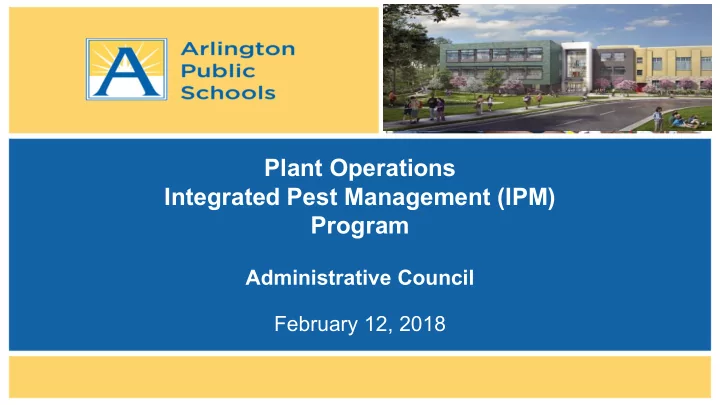

Plant Operations Integrated Pest Management (IPM) Program Administrative Council February 12, 2018
What is Integrated Pest Management (IPM)? IPM is an environmentally-friendly program that reduces human exposure to pesticides using the least toxic and most effective way to control pest populations. IPM relies on pest biology, behavior and life cycle in order to control pest populations. IPM is a proactive approach to pest control by implementing inspection and prevention strategies. IPM reduces health risks to students and staff. 2
IPM Mandates and Guidelines • In February 2009, the Virginia state legislature passed House Bill 1836 which required that guidelines for implementing Integrated Pest Management (IPM) be made available to Virginia schools (VA code 22.1-132.2). • Required in WV, MD, PA • It is a national movement and endorsed by the US Dept. of Agriculture and every state level department of agriculture. • VA State Department of Education strongly recommends an IPM program in all schools. • The VA Pesticide Control Act requires all applicators on school property to be licensed. 3
Plant Operations Scope of Responsibility • 41 buildings • 4.9 million square feet of interior space • 400 acres of land/exterior grounds • Each building is inspected and treated once per month • Core areas inspected once per month: main offices, restrooms, clinics, kitchens and cafeterias, multi-purpose rooms, Family and Consumer Science kitchens, teacher lounges and exterior grounds 4
Types of Pests Found on APS Property • Plant: poison ivy • Insects: roaches, head lice, stinging insects (ground bees, wasps, hornets, carpenter bees), mites, flies, swarming ants, termites, cluster flies • Animals: raccoons, bats, snakes, rats, mice 5
Focus of Pest Control Pest control focuses on prevention strategies: Sanitation/housekeeping Maintenance Monitoring Inspection Eliminating food and water sources, harborage opportunities 6
Wh a t Happens During Pest Control Technician Visits? • Pest control technician arrives after 4:00 pm • Reviews pest sighting log • Locates building supervisor or lead custodian to be escorted around the building • Inspects: 1. All areas indicated in log book 2. Core areas (kitchens, cafeteria, restrooms, clinic, main office, etc.) 3. Areas submitted through work orders 4. Areas identified in emails from Plant Operations 5. Verbal feedback from custodial staff during inspections • Pest control technician fills out IPM report 7
IPM Inspection Report • Vendor sends reports to Plant Operations • Plant Operations reviews reports • Plant Operations meets monthly with vendors • Copies of reports forwarded to Principals 8
Communication is Vital • Principals are asked to discuss pest control program with staff and teachers at beginning of school year. o Share pest control schedule with all staff o Reinforcement of pest control recommendations o Communicate location of pest control log book o Ask staff to report issues in the pest control log book o Everyone should report any incidents in the log book • Plant Operations is available to meet with staff to discuss concerns. 9
Everyone participates in Pest Control! administrators and office staff, teachers, custodians, cafeteria and extended day staff (administrators, teachers, office staff, cafeteria, extended day staff and custodians) 10
Pest Control Prevention • Eliminate food sources in order to reduce pest issues • Follow through on recommendations on the pest control reports • Place food in durable sealed plastic containers • Keep exterior doors closed • Reduce clutter in classrooms • Submit “Work Orders” to repair structural cracks and crevices, install door sweeps and seal holes around pipes • Do not hang bird feeders near the building or in court yards • Do not leave food out overnight • Keep work areas tidy 11
Future Developments 1. Currently reviewing and editing the pest control contract for re-bid – Breakfast in Classrooms – Grab and Go breakfast – Annual ant treatment around buildings and relocatables 2. Next day turnaround on IPM reports 3. Transitioning paper sighting log to electronic format (Google Docs or Share Point 360) to allow better data collection – Mobile accessibility via laptop/PC, iPhone, iPad – To be implemented during the summer 4. Researching data collection software to effectively monitor pest control issues 12
Recommend
More recommend